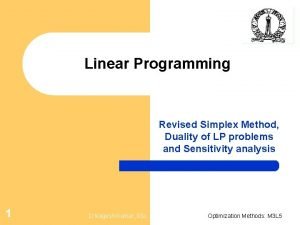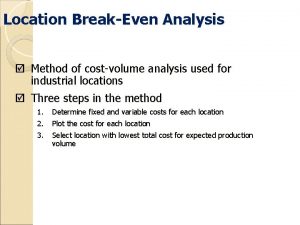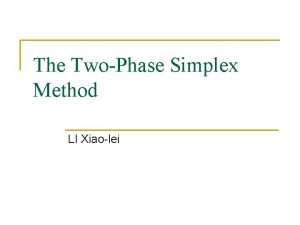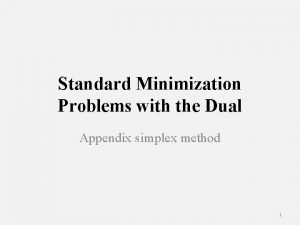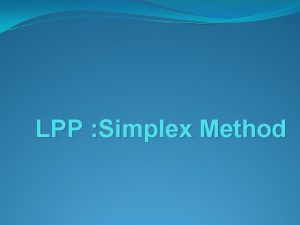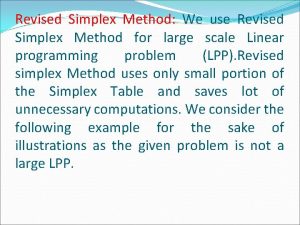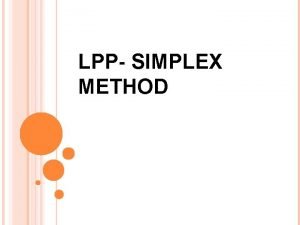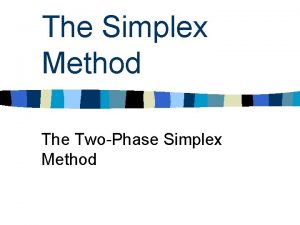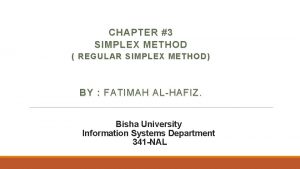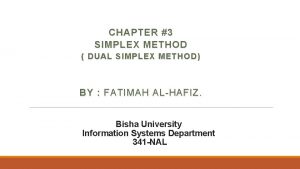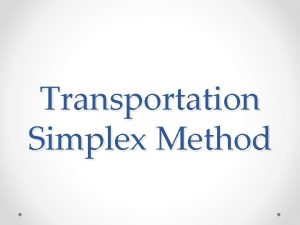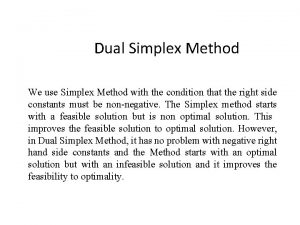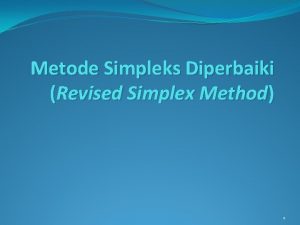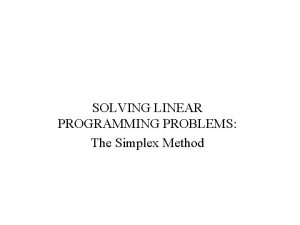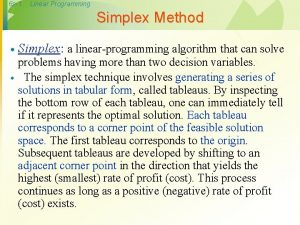The Simplex Method 2 Steps involved Locate an












- Slides: 12


The Simplex Method (2) Steps involved: Locate an extreme point of the feasible region. . 1 Examine each boundary edge intersecting at this point to see. 2 whether movement along any edge increases the value of the objective function. If the value of the objective function increases along any edge, . 3 move along this edge to the adjacent extreme point. If several edges indicate improvement, the edge providing the greatest rate of increase is selected. Repeat steps 2 and 3 until movement along any edge no longer. 4 increases the value of the objective function. v

The Simplex Method (3) Example: Product Mix Problem The N. Dustrious Company produces two products: I and II. The raw material requirements, space needed for storage, production rates, and selling prices for these products are given below: The total amount of raw material available per day for both products is 15751 b. The total storage space for all products is 1500 ft 2, and a maximum of 7 hours per day can be used for production. The company wants to determine how many units of each product to produce per day to maximize its total income.

The Simplex Method (4) Solution Step 1: Convert all the inequality constraints into equalities by the v use of slack variables. Let: As already developed, the LP model is: …. . Eq (4)

The Simplex Method (5) Introducing these slack variables into the inequality constraints and v rewriting the objective function such that all variables are on the lefthand side of the equation. Equation 4 can be expressed as: …. . Eq (5)

The Simplex Method (6) Since the coefficients of x 1 and x 2 in Eq. (A 1) are both negative, the v value of Z can be increased by giving either x 1 or x 2 some positive value in the solution. In Eq. (B 1), if x 2 = S 1 = 0, then x 1 = 1500/4 = 375. That is, there is only v sufficient storage space to produce 375 units at product I. From Eq. (C 1), there is only sufficient raw materials to produce 1575/5 v = 315 units of product I. From Eq. (D 1), there is only sufficient time to produce 420/1 = 420 v units of product I. Therefore, considering all three constraints, there is sufficient v resource to produce only 315 units of x 1. Thus the maximum value of x 1 is limited by Eq. (C 1).

The Simplex Method (7) Step 2: From Equation CI, which limits the maximum value of x 1. v …. . Eq (6) Substituting this equation into Eq. (5) yields the following new formulation of the model. …. . Eq (7)

The Simplex Method (8) It is now obvious from these equations that the new feasible solution v is: x 1 = 315, x 2 = 0, S 1 = 240, S 2 = 0, S 3 = 105, and Z = 4095 It is also obvious from Eq. (A 2) that it is also not the optimum v solution. The coefficient of x 1 in the objective function represented by A 2 is negative ( -16/5), which means that the value of Z can be further increased by giving x 2 some positive value.

The Simplex Method (9) Following the same analysis procedure used in step 1, it is clear that: v In Eq. (B 2), if S 1 = 0, then x 2 = (5/13)(240) = 92. 3. v From Eq. (C 2), x 2 can take on the value (5/3 )(315) = 525 if x 1 = S 2 = v 0 From Eq. (D 2), x 2 can take on the value (5/7)(105) = 75 if S 2 = S 3 = v 0 Therefore, constraint D 2 limits the maximum value of x 2 to 75. Thus a v new feasible solution includes x 2 = 75, S 2 = S 3 = 0.

The Simplex Method Step (10)3: From Equation D 2: v …. . Eq (8) Substituting this equation into Eq. (7) yield: …. . Eq (9) From these equations, the new feasible solution is readily found to be: x 1 = 270, x 2 = 75, S 1 = 45, S 2 = 0, S 3 = 0, Z = 4335.

The Simplex Method (11) Because the coefficients in the objective function represented by Eq. v (A 3) are all positive, this new solution is also the optimum solution.

Simplex Tableau for Maximization (1) Step I: Set up the initial tableau using Eq. (5). v …. . Eq (5) In any iteration, a variable that has a nonzero value in the solution is called a basic variable.
 Simplex method steps
Simplex method steps Dual simplex method maximization example
Dual simplex method maximization example Describe the steps involved in portfolio selection
Describe the steps involved in portfolio selection Process of making pochampally sarees
Process of making pochampally sarees Output designs
Output designs Explain the steps involved in controlling process
Explain the steps involved in controlling process Steps involved in developing and running a local applet
Steps involved in developing and running a local applet Principles of admission in hospital
Principles of admission in hospital Location break even analysis
Location break even analysis Data analysis in historical research
Data analysis in historical research Two phase simplex method example
Two phase simplex method example Network simplex method
Network simplex method Simplex minimization problem
Simplex minimization problem

